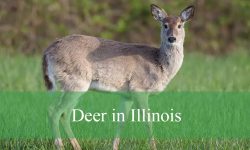Michigan hosts a wide variety of hawks, from the majestic Red-tailed Hawk to the swift Sharp-shinned Hawk. These raptors dominate the state’s skies, soaring gracefully over forests, wetlands, and farmlands. Each species plays a vital role in maintaining balance within Michigan’s natural ecosystems.
Across the seasons, hawks can be seen circling over open country, gliding silently through woodlands, or hovering above frozen fields in search of prey. Their sharp vision, strength, and agility make them some of the most skilled hunters in the bird world. Watching them in action reveals the wild beauty of Michigan’s landscapes.
This guide introduces 12 hawk species found in Michigan, complete with detailed identification tips, feeding habits, and preferred habitats. Learning about these birds offers a deeper understanding of how they thrive and adapt throughout the Great Lakes region.
Common Types of Hawks Found in Michigan
Red-tailed Hawk (Buteo jamaicensis)
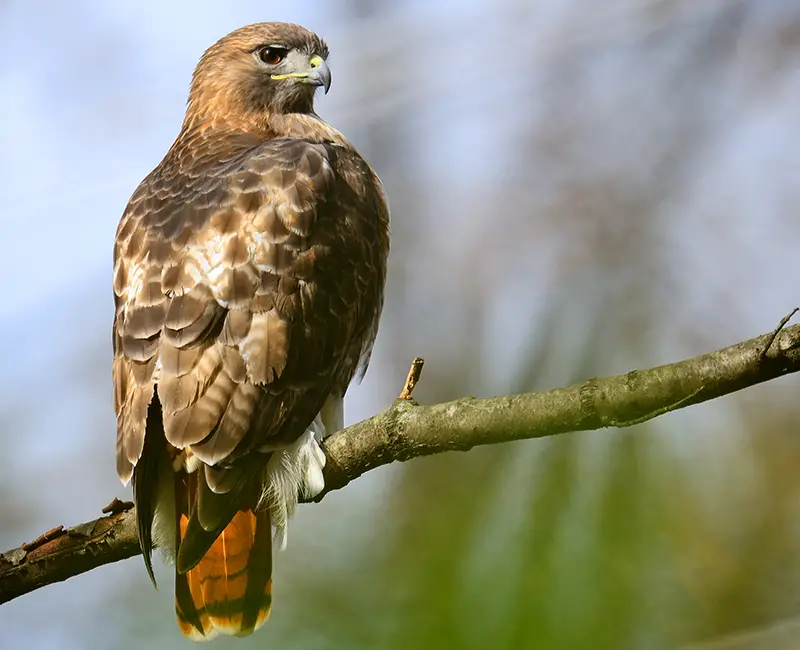
The Red-tailed Hawk is one of the most widespread and recognizable hawks in Michigan. It features a broad, rounded wing shape and a short, wide tail that gives it excellent maneuverability during flight. Adults are easily identified by their characteristic reddish-brown tail, pale underparts, and dark belly band. Their cry — a raspy, descending “kee-eeeer” — is one of the most familiar sounds in North American woodlands and open skies.
This species typically measures about 18 to 26 inches in length, with a wingspan ranging from 43 to 57 inches. Females are generally larger than males, as is typical among raptors. When soaring, the Red-tailed Hawk holds its wings in a slight “V” shape and can often be seen circling high above highways and fields, scanning for prey with its keen eyesight.
Red-tailed Hawks are versatile predators. Their diet mainly consists of small mammals such as voles, rabbits, and squirrels, though they occasionally take birds, reptiles, and carrion. They hunt either from perches or by soaring slowly and dropping suddenly on unsuspecting prey. Their adaptability to different prey and hunting styles makes them successful across varied landscapes.
In Michigan, Red-tailed Hawks are year-round residents. They are most commonly found in open habitats, including farmland, grasslands, and forest edges. They build large stick nests, usually high in trees, and often return to the same nesting sites each year. Their ability to thrive in both rural and suburban areas makes them one of Michigan’s most visible and admired raptors.
Cooper’s Hawk (Accipiter cooperii)
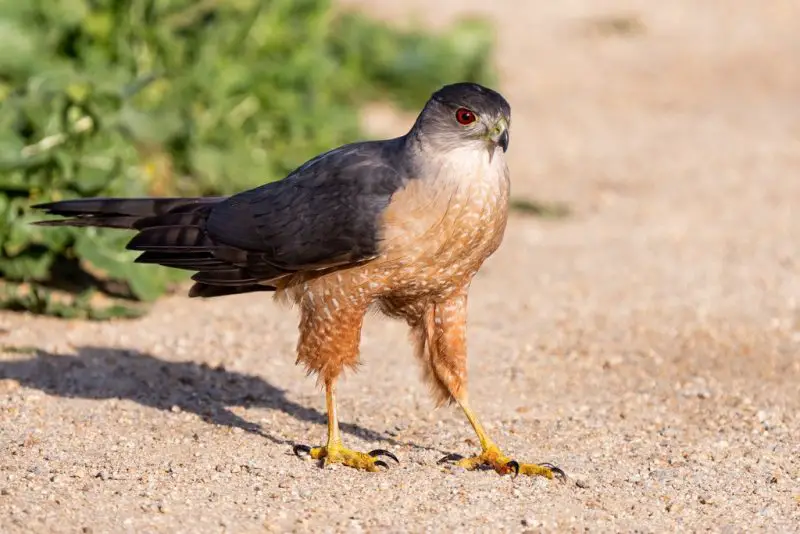
The Cooper’s Hawk is a sleek and powerful forest hunter known for its rounded wings and long tail, which help it navigate dense woodland environments with precision. Adults have bluish-gray backs, reddish-barred chests, and sharp yellow eyes that turn red as they mature. Juveniles are brown above with streaked underparts, making them harder to distinguish from Sharp-shinned Hawks.
These hawks range from 14 to 20 inches long with wingspans between 24 and 35 inches. Their long, rounded tail with dark bands and white tips is a key field mark. When in flight, Cooper’s Hawks show a steady flap-flap-glide pattern, and they are known for their remarkable agility when chasing birds through tight forest canopies.
Cooper’s Hawks are primarily bird hunters. They prey on species such as robins, starlings, pigeons, and mourning doves. They are ambush predators, often surprising their prey by darting through trees or striking suddenly from cover. They also occasionally eat small mammals like chipmunks or squirrels, depending on availability.
In Michigan, Cooper’s Hawks are common year-round, especially in wooded suburbs and city parks where songbirds are abundant. They nest in tall conifers or hardwoods, constructing stick nests lined with bark and greenery. Despite being secretive during breeding season, they’ve adapted well to urban environments, making them one of the most successful raptors in Michigan’s changing landscape.
Sharp-shinned Hawk (Accipiter striatus)
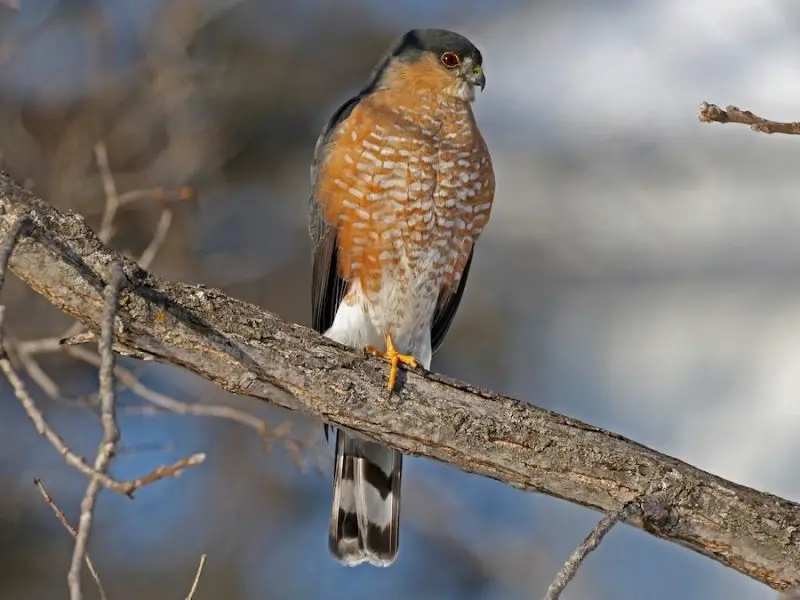
The Sharp-shinned Hawk is the smallest hawk found in Michigan, known for its short wings and long tail that enable swift, agile flight through dense trees. Adults have bluish-gray upperparts and fine reddish barring on the chest, while juveniles show brown streaking on the underparts. Their small size and quick, darting flight make them easy to mistake for large songbirds at first glance.
This hawk typically measures 9 to 13 inches in length, with a wingspan of 17 to 23 inches. The squared-off tail and tiny head that barely extends past the wings in flight help distinguish it from the similar but larger Cooper’s Hawk. Females are about one-third larger than males, an adaptation that allows them to hunt slightly bigger prey.
Sharp-shinned Hawks primarily feed on small birds, including sparrows, finches, and warblers. They often ambush their prey at backyard feeders or forest edges, using stealth and speed rather than strength. These hawks are skilled aerial hunters, weaving through trees in pursuit of their quarry with astonishing precision.
In Michigan, Sharp-shinned Hawks are mostly seen during migration in spring and fall, though some remain year-round in the southern part of the state. They prefer dense coniferous or mixed forests for nesting and roosting but are increasingly spotted near suburban bird feeders. Their adaptability and hunting prowess make them a key predator in balancing songbird populations.
Red-shouldered Hawk (Buteo lineatus)
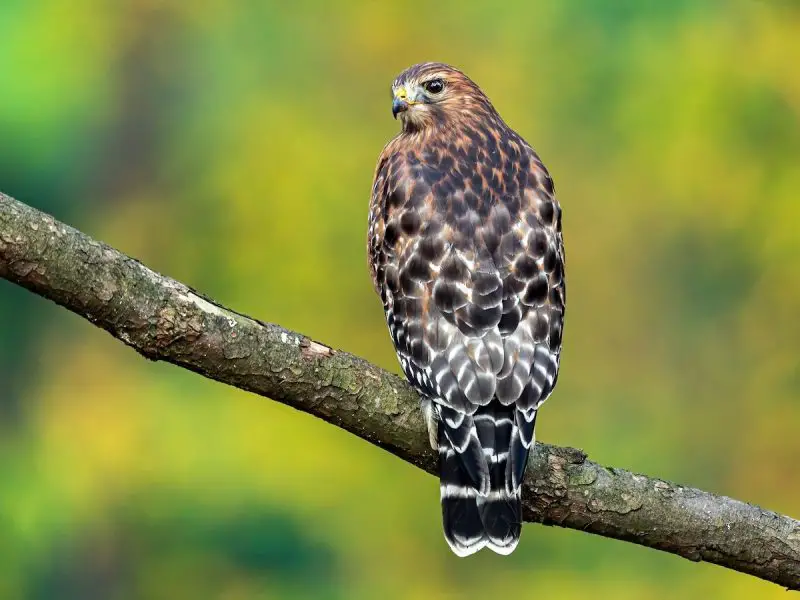
The Red-shouldered Hawk is a striking bird with rich reddish barring on its chest and a warm brown back accented by pale checkering. Its most distinguishing feature is the reddish “shoulders” visible on the upper wings, which stand out during flight. Adults also have bold black-and-white banded tails and translucent crescents on their wingtips, visible when gliding overhead.
This medium-sized hawk measures about 17 to 24 inches long with a wingspan of 37 to 43 inches. It has a loud, repetitive “kee-ah” call that echoes through wooded wetlands — a signature sound of spring in many Michigan forests. Compared to the larger Red-tailed Hawk, it has a slimmer body and more rounded wings, giving it a graceful flight pattern.
Red-shouldered Hawks primarily hunt small mammals, amphibians, reptiles, and occasionally birds. They often perch silently on low branches near water, waiting to pounce on frogs or mice. Unlike some hawks that prefer open country, this species thrives in dense woodlands, particularly near rivers, swamps, and forested wetlands.
In Michigan, the Red-shouldered Hawk breeds mainly in the southern and central parts of the state. It favors mature forests with open understories, building large stick nests lined with fresh greenery. Because of habitat loss, they were once less common, but recent conservation and reforestation efforts have helped their numbers recover in suitable habitats.
Broad-winged Hawk (Buteo platypterus)
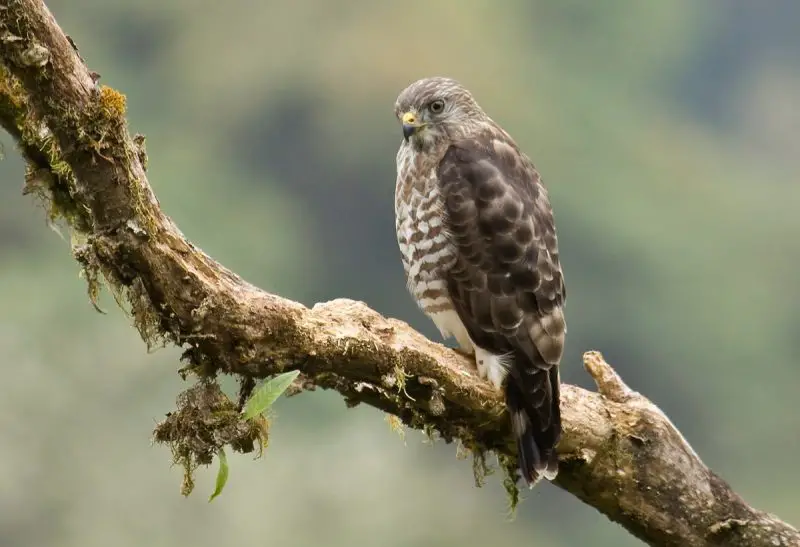
The Broad-winged Hawk is a compact, stocky raptor known for its wide, rounded wings and short tail. Adults have brown upperparts and pale underparts with distinct horizontal barring on the chest and tail. During flight, the tail shows a striking pattern of two white bands against a dark background, making this species easy to identify from below.
This hawk typically measures 13 to 17 inches long with a wingspan of 31 to 39 inches. Despite its small size, it is a powerful flyer, often seen soaring high in circles during migration. In late summer, thousands of Broad-winged Hawks form large flocks called “kettles,” creating a spectacular sight as they ride thermal currents southward.
Broad-winged Hawks primarily feed on small mammals, amphibians, reptiles, and insects. They hunt from perches in the forest, swooping down to capture prey on the ground. Their hunting behavior is deliberate and efficient, relying on patience and quick bursts of speed. During nesting season, they often bring a variety of prey back to feed their young.
In Michigan, Broad-winged Hawks breed in forested regions throughout the state, particularly in northern hardwood and mixed conifer forests. They prefer areas near water, building nests in tall trees with dense canopy cover. Although they are secretive during the breeding season, their fall migration provides some of the most dramatic hawk-watching opportunities in the Great Lakes region.
Rough-legged Hawk (Buteo lagopus)
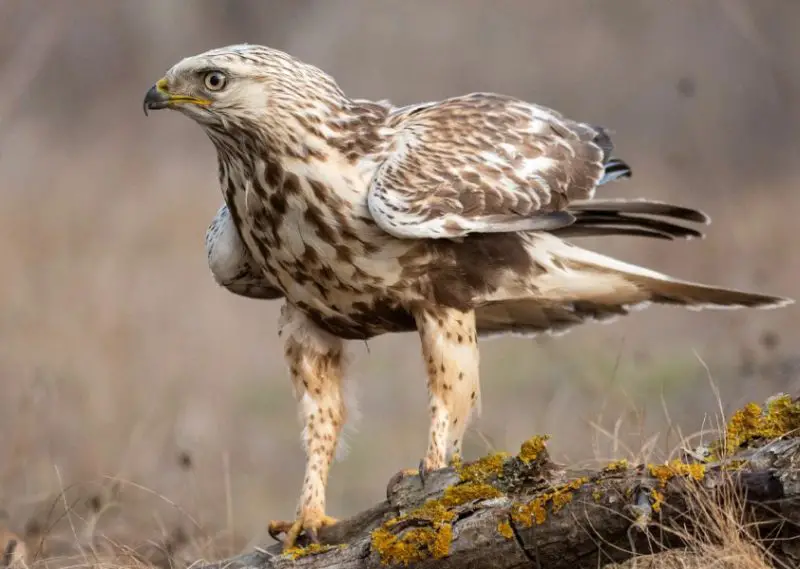
The Rough-legged Hawk is a winter visitor to Michigan, easily recognized by its feathered legs — a feature that helps it endure cold northern climates. Adults display a light or dark morph, with the light form being more common. Light morphs show pale underparts with a dark belly band and wrist patches, while dark morphs are mostly chocolate brown with lighter flight feathers. Both have a distinctive black tail band and long, narrow wings.
This species measures between 18 and 24 inches long, with a wingspan reaching 52 to 54 inches. In flight, Rough-legged Hawks hold their wings in a shallow “V” and hover gracefully while scanning for prey. Their flight style is buoyant and deliberate, allowing them to remain nearly stationary in the wind — a rare trait among large hawks.
Rough-legged Hawks primarily feed on small mammals, especially voles and lemmings, which they locate using their sharp eyesight. In Michigan’s open farmlands and marshes, they also take mice and rabbits during the winter months. They often perch on fence posts or utility poles, using elevated spots to spot movement in snow-covered fields.
These hawks breed in the Arctic tundra and migrate south to Michigan in late fall, staying through early spring. They favor open country, including agricultural fields, coastal dunes, and prairies. As soon as northern snow begins to melt, they return to their breeding grounds, making them a special seasonal sight for Michigan birdwatchers.
Northern Harrier (Circus hudsonius)
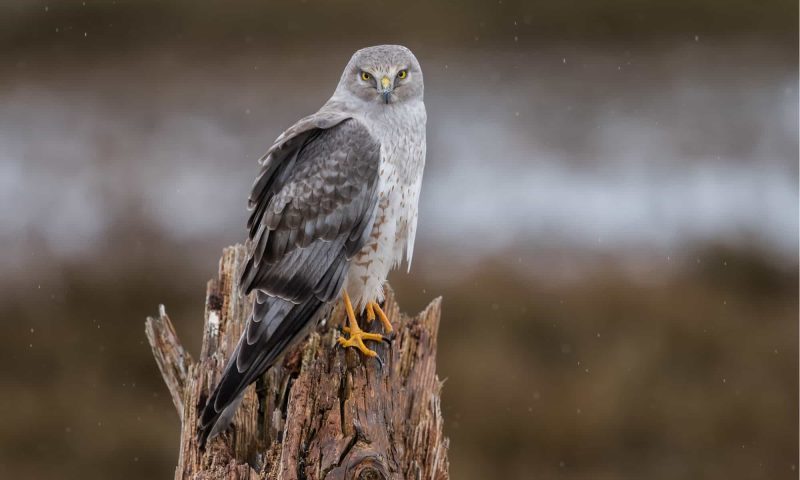
The Northern Harrier is a sleek, long-winged hawk often seen gliding low over marshes and fields in Michigan. It has an owl-like facial disc that helps direct sound to its ears, giving it exceptional hearing for detecting prey. Males are pale gray with black wingtips, while females and juveniles are brown with streaked undersides. A white rump patch visible in flight is a key identifying feature.
This medium-sized raptor measures about 18 to 20 inches long with a wingspan of 40 to 46 inches. Its long tail and slim body allow it to maneuver close to the ground, weaving gracefully as it hunts. Unlike most hawks, the Northern Harrier relies heavily on both sight and sound to locate prey, similar to owls.
Northern Harriers primarily eat small mammals, especially voles, mice, and rabbits, but they also take birds, reptiles, and amphibians. They fly low, gliding just a few feet above the ground, before suddenly dropping onto unsuspecting prey. Their hunting behavior is both elegant and efficient, making them fascinating to observe in open landscapes.
In Michigan, Northern Harriers are year-round residents in the southern regions and migratory visitors in the north. They nest on the ground in thick grass or marsh vegetation, often in wetlands or tall prairie grasses. Because they depend on open, undisturbed habitats, conservation of Michigan’s grasslands and marshes is crucial for maintaining healthy harrier populations.
Northern Goshawk (Accipiter gentilis)
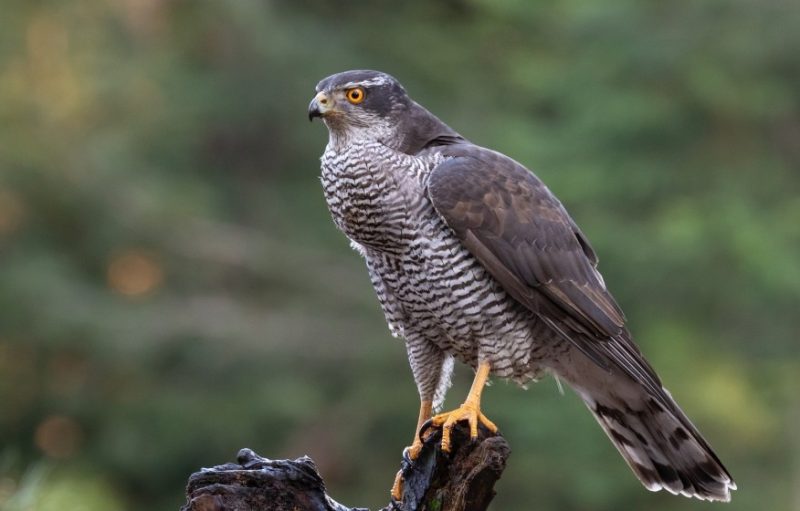
The Northern Goshawk is a powerful, secretive forest raptor and the largest member of the Accipiter family in Michigan. It is distinguished by its slate-gray back, pale gray chest with fine barring, and striking red eyes. Its fierce expression and bold white eyebrow stripe give it an unmistakably intense look. Juveniles are brown above with heavy streaking below, blending well into dense forests.
Northern Goshawks measure about 20 to 26 inches in length and have a wingspan between 40 and 46 inches. Their broad wings and long tail provide excellent control when flying through wooded areas. Known for their stealth, they can dart through trees at high speeds, capturing prey with deadly precision. Their flight is smooth and powerful, alternating between strong wingbeats and short glides.
These hawks hunt a wide range of prey, including squirrels, rabbits, grouse, crows, and even other raptors. They are ambush predators, relying on cover and speed to surprise their targets. Once committed to a chase, a Goshawk rarely misses — a testament to its strength and agility. They defend their nests aggressively, often driving away larger birds and even humans that venture too close.
In Michigan, Northern Goshawks breed primarily in the Upper Peninsula and northern Lower Peninsula, where mature coniferous and mixed forests provide ample cover. They prefer remote woodlands, making sightings relatively rare. During winter, some individuals move south, occasionally venturing into southern Michigan. Their secretive nature and loyalty to large tracts of forest make them a symbol of wilderness in the state.
Swainson’s Hawk (Buteo swainsoni)
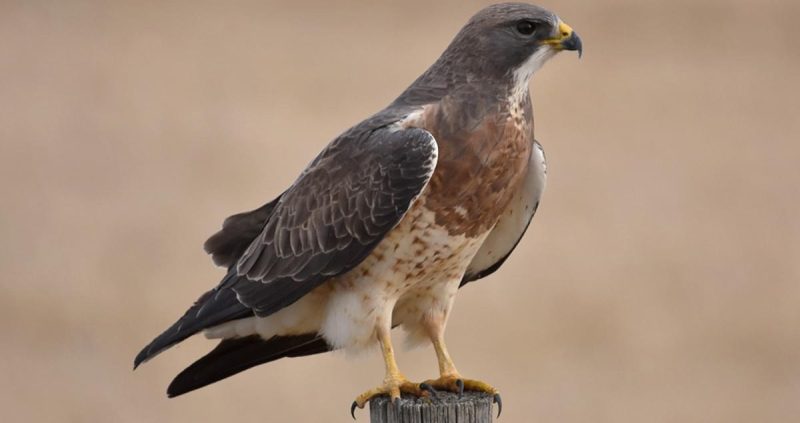
Swainson’s Hawk is a long-distance migrant that occasionally visits Michigan during spring and fall. This medium-to-large hawk has long, narrow wings and a short, square tail. Adults are grayish-brown above with pale underparts and a contrasting dark chest bib. The flight feathers appear lighter, giving the wings a two-toned look from below — a useful field mark during migration.
These hawks measure around 18 to 22 inches long, with wingspans ranging from 46 to 54 inches. They are built for soaring, often circling high in thermals during migration in large groups called “kettles.” Their flight style is smooth and steady, allowing them to travel thousands of miles between breeding and wintering grounds.
Swainson’s Hawks feed on small mammals such as ground squirrels and rabbits during the breeding season but switch to a diet rich in insects, especially grasshoppers, during migration. They hunt from perches or the air, often following tractors to catch disturbed prey in open fields. Their dietary flexibility helps them survive long journeys across diverse habitats.
In Michigan, Swainson’s Hawks are considered uncommon migrants, with occasional sightings in open farmland and grassland regions. They breed primarily in the Great Plains and western states, but a few individuals pass through the Great Lakes area each year. Their remarkable migration — spanning from North America to Argentina — makes them one of the most impressive travelers among all raptors.
Ferruginous Hawk (Buteo regalis)
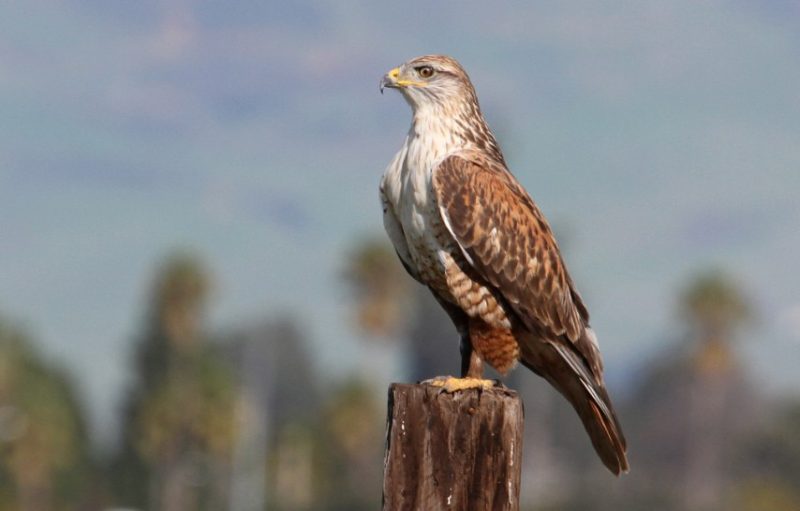
The Ferruginous Hawk is the largest hawk in North America and a rare visitor to Michigan. Its name comes from the Latin word for “rusty,” referring to the reddish-brown tones on its shoulders, legs, and back. Adults have pale heads and underparts, with rusty streaks forming a “V” shape on the belly. Their large size and long, broad wings give them a majestic appearance when soaring.
These hawks typically measure 22 to 27 inches long, with wingspans up to 56 inches. Their legs are fully feathered down to the toes, similar to the Rough-legged Hawk. In flight, the Ferruginous Hawk’s pale underwings and bright white tail stand out clearly. They are strong fliers, capable of covering great distances in search of prey.
Ferruginous Hawks primarily hunt small to medium-sized mammals, such as prairie dogs, ground squirrels, and rabbits. They use a combination of soaring and perch hunting, scanning open ground for movement. When prey is spotted, they dive swiftly and capture it with their large, powerful talons. Their hunting style reflects both patience and brute strength.
In Michigan, Ferruginous Hawks are extremely rare and typically appear only during migration or winter wandering. They prefer open country such as grasslands, plains, and agricultural areas, where they can easily spot prey. Though uncommon in the Great Lakes region, an occasional sighting of this magnificent western hawk always excites local birders.
Harris’s Hawk (Parabuteo unicinctus)
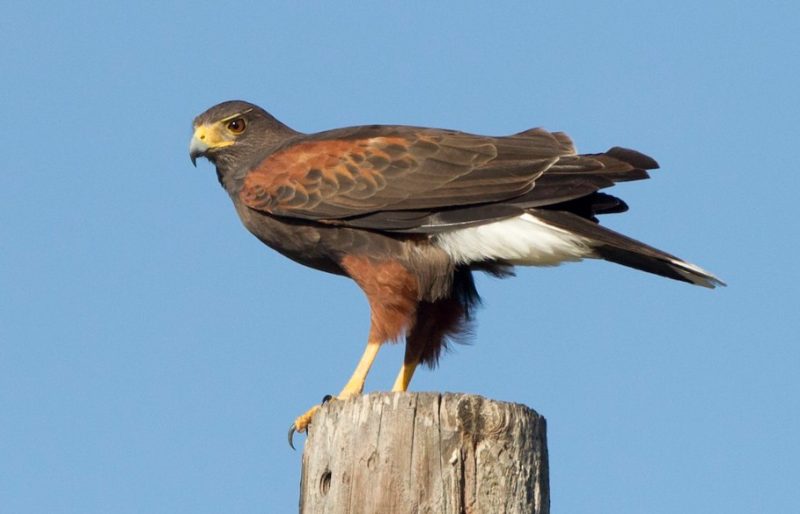
Harris’s Hawk is a unique and intelligent raptor, known for its social hunting behavior — a rare trait among hawks. It has dark brown plumage with chestnut shoulders and thighs, along with white markings on the rump and tail tip. Its long legs and upright posture give it a regal appearance when perched. This species’ cooperative nature and adaptability have made it a favorite among falconers.
Adults measure between 18 and 23 inches long, with wingspans from 40 to 47 inches. They are agile fliers, using short bursts of speed and teamwork to chase prey. Their hunting strategy often involves groups of two to six individuals, taking turns flushing out and catching small mammals or birds. This cooperative behavior helps ensure hunting success even in challenging conditions.
Harris’s Hawks primarily eat rabbits, rodents, and small birds. Their group hunting technique is efficient — one bird may flush the prey while others position themselves strategically to capture it. They are also known to perch together and share food, strengthening social bonds within the group.
In Michigan, Harris’s Hawks are extremely rare visitors, typically seen only as escapees from falconry or during irregular dispersal events. They prefer desert scrub and open woodland habitats, so the climate of Michigan is outside their normal range. Any confirmed sighting of this species in the state is a notable event among birdwatchers.
Gray Hawk (Buteo plagiatus)
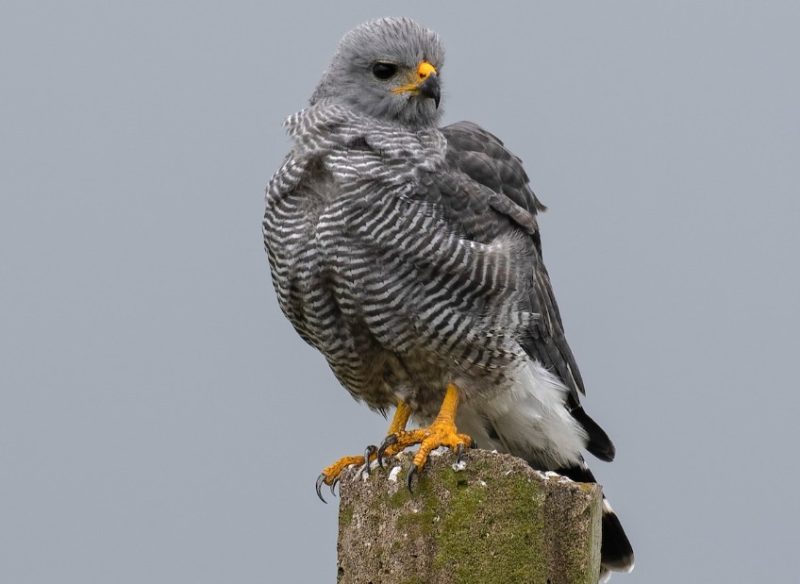
The Gray Hawk is a very rare stray in Michigan, typically found much farther south in Mexico and the southwestern United States. It is a small, elegant hawk with fine gray barring across its chest and belly, pale underwings, and a strikingly banded black-and-white tail. The overall gray tone of its plumage gives it a smooth, uniform appearance, especially in bright sunlight.
Measuring about 16 to 24 inches in length with a wingspan between 32 and 39 inches, the Gray Hawk is compact and agile. It has short, rounded wings and a long tail, allowing precise control in dense forests or riparian corridors. Its flight is buoyant, often punctuated by quick, shallow wingbeats followed by glides.
Gray Hawks primarily feed on reptiles, especially lizards and small snakes, but they also take birds and small mammals. They prefer to perch quietly on branches, watching for movement below before diving swiftly to capture prey. Their hunting style is methodical and patient, often conducted from shaded perches in wooded areas near water.
In Michigan, Gray Hawks are accidental visitors, occasionally appearing during migration or after being displaced by storms. Their presence is exceptionally rare, as they typically inhabit the warm woodlands of the American Southwest and Mexico. A confirmed sighting in Michigan is an extraordinary record and a highlight for any serious birder.
Tips for Watching Hawks in Michigan
Hawk watching in Michigan can be a deeply rewarding experience, especially during migration seasons when raptors fill the sky. The best times to observe hawks are during spring and fall, particularly along the Great Lakes and open countryside where thermals help birds soar with minimal effort. Early morning and late afternoon provide ideal lighting conditions for identification.
To increase your chances of spotting different species, visit open areas such as grasslands, coastal dunes, and forest edges. Hawk Ridge in Duluth (just across Lake Superior) and Pointe Mouillee State Game Area in southeastern Michigan are excellent spots to witness large numbers of migrating hawks. Bringing binoculars or a spotting scope helps distinguish features like tail patterns, underwing markings, and flight shapes.
Be patient and attentive to their flight behavior. Broad-winged Hawks often travel in groups, while Red-tailed Hawks prefer to circle alone or in pairs. Rough-legged Hawks hover frequently, unlike most other buteos. Also, consider weather conditions — calm, sunny days with rising thermals attract soaring hawks, while strong winds may push them closer to the ground.
Providing a natural habitat in your own yard can also draw hawks closer for observation. Maintaining bird feeders, leaving brush piles, and keeping tall trees can attract small prey species, indirectly bringing hawks such as Cooper’s and Sharp-shinned Hawks into view. Always observe responsibly and avoid disturbing nesting sites or young raptors.
FAQs about Hawks in Michigan
What time of year can I see the most hawks in Michigan?
The best time to see hawks in Michigan is during spring (April–May) and fall (September–October) migration periods. During these months, thousands of hawks pass through the state along major migration routes near the Great Lakes, making them easier to spot in large numbers.
Are hawks in Michigan dangerous to pets?
While most hawks prefer wild prey like rodents and birds, small pets such as kittens or toy-sized dogs could be at slight risk, especially from larger species like the Red-tailed Hawk. However, such incidents are extremely rare. Keeping pets supervised when outdoors eliminates nearly all risk.
Do hawks stay in Michigan all year?
Some species, like the Red-tailed Hawk and Cooper’s Hawk, live in Michigan year-round. Others, such as the Rough-legged Hawk and Broad-winged Hawk, migrate seasonally. The Rough-legged Hawk winters in Michigan, while Broad-winged Hawks arrive only during the breeding months before flying south in the fall.
Where is the best place to see hawks in Michigan?
Excellent hawk-watching locations include Pointe Mouillee State Game Area, Kensington Metropark, and the Mackinac Straits area. These spots offer open views and are known migration corridors. The Upper Peninsula also provides prime opportunities to see Northern Goshawks and Rough-legged Hawks in winter.
How can I tell the difference between a Cooper’s Hawk and a Sharp-shinned Hawk?
Cooper’s Hawks are larger, with rounded tails and heads that extend well beyond the wings in flight. Sharp-shinned Hawks are smaller, with squared tails and shorter heads. Observing them near bird feeders can help with comparison — Cooper’s Hawks usually go after larger prey, while Sharp-shinned Hawks focus on small songbirds.
What do hawks eat in Michigan?
Hawks in Michigan have diverse diets depending on the species. Red-tailed Hawks mainly eat small mammals like voles and rabbits, while Cooper’s and Sharp-shinned Hawks target birds. Rough-legged Hawks and Northern Harriers often hunt rodents in open fields, and species like the Northern Goshawk include squirrels and game birds in their diet.
Do hawks migrate through Michigan every year?
Yes, Michigan lies along key migratory flyways, and many species travel through the state every year. Broad-winged Hawks, in particular, form massive flocks known as kettles during fall migration. Observers can see thousands of hawks passing overhead in a single day at peak times.
Are hawks protected in Michigan?
All hawks in Michigan are protected under the Migratory Bird Treaty Act. It is illegal to harm, capture, or possess hawks or their nests without proper authorization. Conservation efforts and legal protection have helped maintain healthy hawk populations across the state.
How can I attract hawks to my backyard?
While you shouldn’t directly feed hawks, you can attract them by supporting a healthy backyard ecosystem. Providing shelter, maintaining trees for perches, and avoiding pesticides that kill their prey are excellent steps. Having a bird-friendly yard indirectly attracts hawks looking for food.
Can hawks survive Michigan winters?
Yes, several hawks — including Red-tailed Hawks, Northern Harriers, and Rough-legged Hawks — endure Michigan’s cold winters. Red-tailed Hawks often remain active year-round, while Rough-legged Hawks actually migrate to Michigan from the Arctic during winter, finding the state’s open fields ideal for hunting small mammals.





